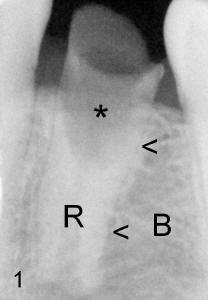





 |
 |
 |
 |
 |
 |
Dental Education Lecture: How does implant stay in our jaw?
Implant-supported restoration such as crown not only looks beautiful, but also works well. How?
One of Mr. Xu's teeth has special defect by birth. Finally the crown has a cavity (* in Fig.1). The tooth needs extraction by taking out its root (R). Normally our tooth stays in the jaw, because the bone (B) binds to the root (arrowheads).
Three months after extraction, the socket (S in Fig.2) heals, ready for implant. Placement of an implant is like planting a tree. A hole is dug. The root of the tree is buried inside the hole. The upper part of the hole for implant (I in Fig.3) is outlined by white dots. There is a space between white dots and the top portion of implant. Another three months later, the space just mentioned is closed by bone growing (black arrowhead in Fig.4). Bone adapts and binds nicely to the slopes of implant (black dots). The bone also grows into the threads of implant (red arrowhead). Our bone loves implant (titanium alloy). The whole process of bone growth and adaptation to implant is called osteointegration. Two of them glue together and become one body. Now implant is stable in the jaw, ready for abutment (A in Fig.5) and crown (above abutment). Fig.5 is taken 4 months after restoration (abutment and crown placement). White arrowheads indicate bone height at that time. Another 14 months later, bone grows taller (white arrowheads in Fig.6, as compared to those in Fig.5). Our bone grows wherever and whenever there is stimulation. Eating is the best stimulation for jawbone growth, in the same way that exercises build up our muscle and bone.
If we eat normally and brush and floss regularly, implant stays in the jaw for a long, long time.
Xin Wei, DDS, PhD, MS 1st edition 01/14/2011, last revision 09/28/2012